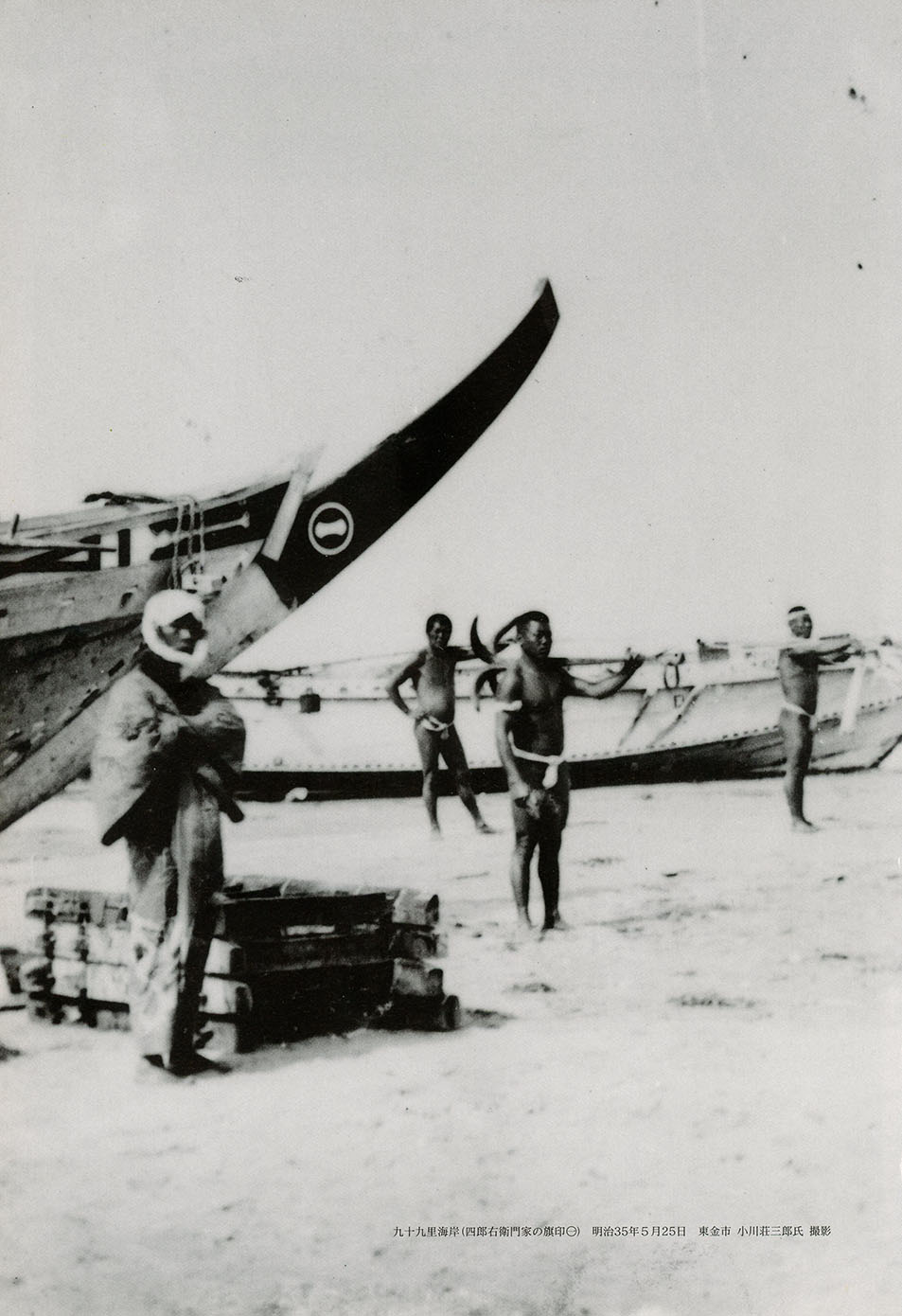
九十九里海岸(四郎右衛門家の旗印(一))
明治35年5月25日 東金市 小川荘三郎氏 撮影
Saitou Kenseki 作品を見る
Nearly 300 years ago from the Genroku period (1688 - 1704) to the last years of the Meiji period (around 1910), sardines not only graced the tables of the common folk, but were often dried and sent to the Kansai area and used as fertilizer for cotton, indigo plants, and tangerines. The great catches of sardines brought enormous wealth to the fishing boss.
The cargos of dried sardines sent to the Kanto and Kansai regions were shipped over land and sea by the merchants of Edo, and traffic between Edo and Kujukuri surged.
Saitou Kenseki, a powerful fishing clan boss and artist was born in the Kansei period 10 (1798) as the second son of Saitou Shirouemon family, a fishing boss known all across Kujukurihama, and named Gensaku.
At age 14, Gensaku was adopted by the powerful family of Nakamura from Ichinomiya.
At the time, the family sat astride Hakuba gin-an, making a line of several hundred retainers (funakata), becoming the talk of the town.
Unfortunately, the brother Shirouemon passed on at an early age. Therefore, he left the adoptive family and took on the responsibilities of household head, becoming the 12th Shirouemon.
Later, he retired as household head while waiting for his brother's child Soukai (see p. 60) to mature. This was when Kenseki was 28 years old.
He left the home of Shitegi miyawaki and built the "Taiyou-an" villa near the ocean, becoming more inclined to painting and writing.
Bunsei period 12 (1829) 31 years old "Nehan zu"
Tenpou period 10 (1839) 41 years old "Akagi jinja no nobori"
Tenpou period 14 (1843) 45 years old "Sansui zu byoubu e"
were some of his works. Later, "Sansui zu byoubu e" was passed into the possession of Mori Ogai, and is currently in the collection of the Tokyo National Museum.
At that time, there were six families of dragnet fishing boss in Minami- and Kita-imaizumi mura, and five families in Shitegi mura. Among these, the most prominent fishing bosses were Kamishiro Heizaemon of Kita-imaizumi mura and Saitou Shirouemon of Shitegi mura. Many artists and writers visited Kujukurihama, which had become prosperous due to sardine fishing and dried sardine production. Iidaka Soube of Ao and Saitou Shirouemon (Kenseki) gladly invited intellectuals from Edo and Kyoto, treating them as teachers who played an important role in developing the culture of the area.
At 44 years old, Kenseki invited the classical Chinese poet Yanagawa Seigan and his wife to Taiyou-an (see p. 59), offering them the bounty of his dragnets. It is said that both famous and unknown artists visited the home of Saitou Shirouemon (Kenseki), such as Takaku Aigai, Fukuda Hankou, Kou Ryuko, Okamoto Shuki, Baiitsu, Kinoshita Itsuun, Taki Katei, Kurimoto Koudou, and Tsubaki Chinzan, telling of the glorious lives of the fishermen at the time.
Tenpou period 13 (1842) 44 years old Traveling to Ashikaga.
Studied under Tsubaki Chinzan
Kaei period 1 (1848) 50 years old "Akagi daimyoujin sonzou" (mokuhan)
Kaei period 6 (1853) 55 years old "Roushou zu"
were some of his works.
Early on the morning of June 3, Kaei period 6 (1853), four ships from foreign countries passed by Izu Peninsula and entered Edo Bay. These foreign ships were none other than the fleet commanded by Commodore Perry.
After spending about two years in Echigo from 64 to 65 years of age, Kenseki took residence in a home near Ueno, but soon returned to Shitegi mura at the end of the Tokugawa shogunate. In the Bunkyu period 2 (1862) he built Kyouju-an, and then a cottage across the way which he named Gun-atei, where it is said that he enjoyed reading, painting, and playing the seven-stringed zither. Kenseki owned the pen names such as Nan-otsu, Kyoseki, Hakuwan Ryouchou, Tozan Seinou, Taiyou-an shujin, Kyouju-an shu, and others.
In the Meiji period 5 (1872), Taki Katei painted the only portrait of Kenseki, however it was lost in the Great Kanto Earthquake.
Calling himself an itinerant, Kenseki toured Japan, refining his artistic sensibilities. Before long, he penned a magnificent letter entitled "Kakioki no koto" (see p. 58), and passed away in May, Meiji period 7 (1874) at 76 years of age.

The great catches of sardines brought tremendous wealth to the fishing bosses, making their lives luxurious. The paper sliding doors of the first floor of his two-story main home were adorned with silver and gold, giving it the dignity of a palace.(Produced in the Meiji period 31 (1898))